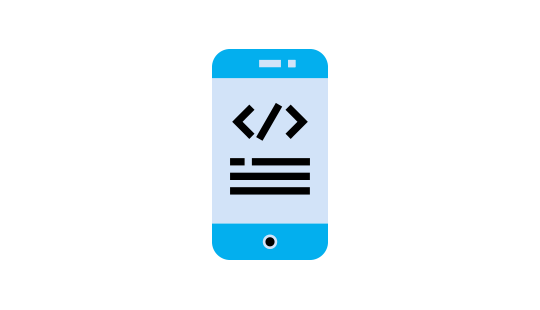Introduction
Mobile apps have become an essential part of our everyday lives in the ever-changing digital world of today. There is an app for everything, be it business, productivity, communication, or amusement. This helpful tutorial will follow you through the crucial phases of designing your first mobile app, with an emphasis on producing a Minimum Viable Product (MVP), if you’ve ever had an idea for one and are excited to bring it to life.

Understanding the Concept of a Minimum Viable Product (MVP)
Before delving into the development process, it’s crucial to understand the concept of a Minimum Viable Product. An MVP is a version of your product that includes only the essential features required to meet the needs of your initial users. The primary goal of an MVP is to release a functional product quickly, gather user feedback, and iterate based on that feedback. This approach allows you to test your app’s viability in the market with minimal resources and investment.
Define Your App’s Purpose and Target Audience
The first step in developing a mobile app is to define its purpose and identify your target audience. What problem does your app solve? What are the needs of the potential users, and who are they? Conduct thorough market research to understand existing solutions, identify gaps, and ensure there’s a demand for your app. This information will guide your development process and help you create a product that resonates with your audience.
Sketch Your App’s User Interface
Once you have a clear idea of your app’s purpose and target audience, start sketching the user interface (UI). Sketching allows you to visualize the layout and flow of your app, including the placement of buttons, navigation, and key features. You don’t need to be an artist; simple sketches on paper or using digital tools can be effective. This step helps you conceptualize your app and make early design decisions.
Read more: The Ultimate Reading List for UX Designers: 10 Books to Expand Your Design Thinking
Choose the Right Development Platform
Choose between creating a cross-platform app that runs on several platforms or a native app that is exclusive to a single platform, like iOS or Android. Each approach has its pros and cons, so consider factors such as your target audience, budget, and development expertise. Tools like React Native and Flutter have gained popularity for cross-platform development, while native development may offer better performance and platform-specific features.
Select Appropriate Technology Stack
Choose the technology stack that best suits your app’s requirements. This includes selecting a programming language, framework, and database. If you’re developing a native app, you’ll need to choose languages such as Swift for iOS or Kotlin/Java for Android. For cross-platform development, frameworks like React Native (JavaScript) or Flutter (Dart) are popular. Consider factors like developer community support, scalability, and ease of maintenance when making these decisions.
Develop the Core Features
With your sketches and technology stack in hand, start developing the core features of your app. Focus on the functionalities that are essential for your app’s primary purpose. Set achievable milestones and regularly test your app’s functionalities as you progress. Remember, the goal at this stage is to create a functional prototype that showcases your app’s key features.
Implement User Feedback Loops
As you develop your MVP, incorporate mechanisms for gathering user feedback. This can include in-app surveys, feedback forms, or beta testing programs. Actively seek input from your target audience to understand their preferences, pain points, and suggestions. User feedback is invaluable for refining your app and making informed decisions for future updates. Embrace an agile development approach, iterating quickly based on the feedback you receive.
Prioritize Performance and Security
While focusing on the development of your MVP, prioritize performance and security. Users expect responsive and fast-loading apps, so optimize your code and assets to deliver a smooth experience. Implement secure coding practices to protect user data and ensure compliance with privacy regulations. Addressing performance and security concerns early in the development process will save you time and resources in the long run.
Test Across Different Devices
Before launching your MVP, thoroughly test your app on a variety of devices and screen sizes. This includes testing on different models of smartphones and tablets to ensure compatibility. Identify and fix any issues related to responsiveness, layout, or functionality that may arise on specific devices. Testing across diverse environments helps you deliver a more reliable app that caters to a broader user base.
Read more: How Can a Mobile App Development Company Attract Customers? (In 2023)
Prepare for App Store Submission
If you’re developing for iOS, prepare to submit your app to the Apple App Store, and for Android, to the Google Play Store. Follow the respective guidelines and requirements for each platform, including app icon design, screenshots, and metadata. Pay attention to app store optimization (ASO) practices to increase your app’s visibility in search results. Thoroughly test the app in a production-like environment to catch any last-minute issues before submission.
Launch and Gather Post-Launch Data
Once your app is live, monitor its performance and gather post-launch data. Use analytics tools to track user engagement, retention, and behavior within the app. Analyzing this data will provide insights into how users are interacting with your app and help you identify areas for improvement. Additionally, continue seeking user feedback and be responsive to bug reports or issues raised by your users.
Conclusion
Developing your first mobile app can be an exciting journey, and creating a Minimum Viable Product is a strategic approach to test your idea in the market with minimal risk. By defining your app’s purpose, understanding your target audience, and following a systematic development process, you can increase the chances of success for your mobile app. Remember, the key to success lies not only in the development process but also in continuously iterating based on user feedback to deliver a product that truly meets the needs of your audience.
